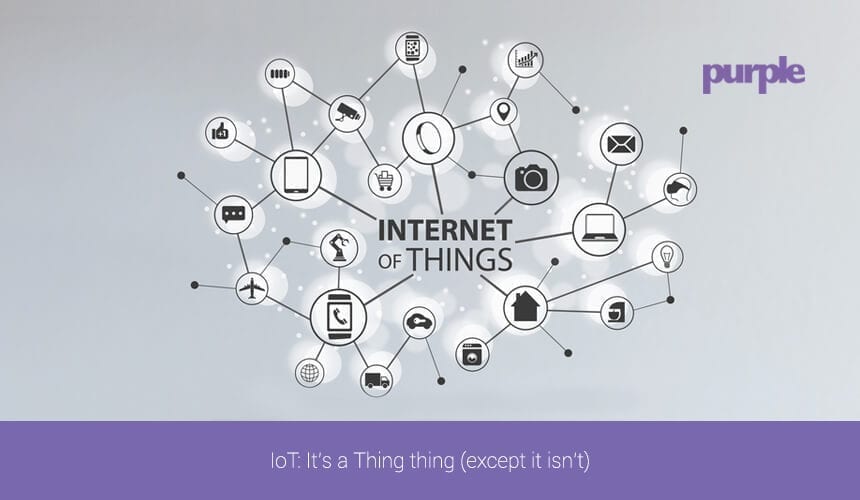When I was asked to write some blog pieces about the Internet of Things, I was both excited – because it is a topic I think is of massive importance – and slightly worried, since the Internet of Things is such a broad subject. There was a temptation to launch into a specific industry and describe the impact that connecting Things would have, and indeed, I will do that in future pieces. However, this first piece is intended to lay out some ground rules and key principles that underpin any Internet of Things opportunity today. Some of these may surprise you, some will sound like screamingly obvious common sense, but all need to be stated so as to make the blog posts that follow a lot easier, a lot shorter, and a lot more specific to their subjects. These are the pre-requisite elements that will be taken as given for the pieces to come.
It’s not about the Thing, it’s about data
It is very easy to get carried away with focusing on whatever it is that is being connected, but that often is not really the point. Connecting something to a network only makes sense if that device is going to generate data that is useful, generates value (either directly or implicitly) or is going to carry out an action based on data generated elsewhere. Connecting a Thing without purpose, and more pertinently, without a business case, is difficult to justify.
As a result, for all of the excitement and marketing material that connecting vehicles, healthcare devices, sensors on production lines, or even livestock might generate, it is only of value if the data can be put to use. The business case for connecting something that previously was unconnected can be very specific to that device, and also, in the early stages can carry considerable costs that need to be offset.
Understanding feasibility
The value of the data that a connected device generates must be balanced against the cost of deploying a connected device. This amounts to:-
- The cost of the connected device itself
- The cost of providing connectivity to the device, and of powering the device
- The cost of maintaining and managing the device
Many of the use cases for connecting a Thing imply putting infrastructure in place that is not currently present. There are large areas of countryside, suburban areas and within buildings that are currently unserved by any form of connectivity infrastructure, either because of technological challenges associated with the environment, or simply because they are places where people rarely go. All connectivity is currently predicated on the consumption of connectivity services by humans, but when the entire purpose is that humans are replaced (or augmented) by connecting a sensor to observe something with greater frequency and accuracy, suddenly a business case for infrastructure can start to be formed.
The challenge is that the first use case needing connectivity has to justify the cost of building out connectivity and the associated infrastructure that goes with it – backhaul connectivity, powering, back-up and disaster response and so on. This either requires a really valuable use case, or the consolidation of many opportunities into a single business case. Often once infrastructure is in place, the economic justification for many other use cases becomes viable.
Silos, Organisations and Exposure of Data
This kind of cross-organisational thinking is often difficult to achieve. Businesses are arranged into divisions, governments at all levels are arranged by departments, and everyone has their own profit and loss to consider, so relinquishing or consolidating management and control of a IoT strategy is difficult to sell to a multi-stakeholder audience. This is compounded by the fact that usually, the data that is to be gathered is considered valuable to the party gathering it. The likelihood is that, in many cases, the Internet is the last place that data will be exposed to.
What actually results is many narrow, application specific Intranets of Things, either limited to a very specific data set or a specific place. Many of the oft-quoted exemplars of IoT proof of concept, focus on a specific thing – rubbish collection, traffic control, parking space management, soil quality – or a specific place – smart building, smart home, smart factory. Very little has actually been done to expose data and cross-correlate it with data gathered by other parties or industries.
The Long Term Goal
That should not depress us. It tells us two things:-
- There are practical, economically sound use cases out there that can start the road to a fully realised Internet of Things, which will in time, justify the infrastructure build to enable many more use cases, and hence a constructive cycle of build, enable, use will ensue
- There is massive pent-up potential still to be realised from data we already have, and data which will be generated in the future.
The journey to an Internet of Things with free-flowing data moving fluidly from industry to industry, and organisation to organisation, is going to be long, but it is also going to be rewarding at every step. In future blogs I’ll start to look at the challenges and opportunities around different sectors, and the technology that enables all of this.
But this is the grounding on which all of that will be based. We are at the start of a long journey, but it is going to be one that revolutionises every industry, business and everyone’s lives. We just need to be smart about how we start out.
